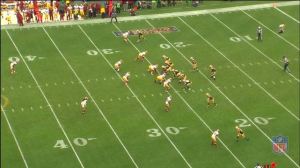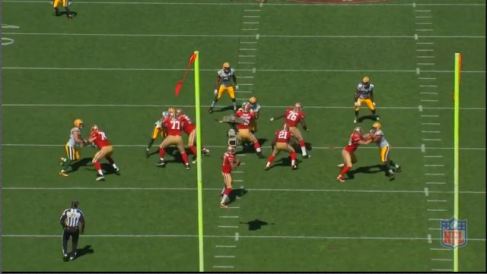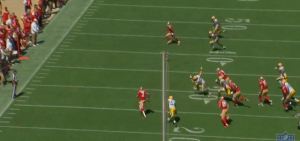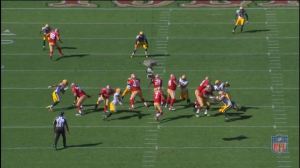- Ugly game by both teams and the officials.
- Some really questionable play-calling from McCarthy/Rodgers. A couple of 3rd and shorts which the Packers elected to pass instead of riding Lacy.
- Lacy ran hard, but at this point is really just a hammer. If he can become a bit more patient in time and stay healthy, he’ll be really good for a while.
- Jordy Nelson is a stud.
- Won’t show in the box score, but the Packers offensive line may have played its best game of the season Sunday.
- I’d like to see the Packers using some of the no huddle looks we saw in the first few weeks of the season. The offense has just had no rhythm the past two weeks.
- I have a ton of respect for Calvin Johnson and his impact on an offense and I still think Detroit is a wild card contender. But Matthew Stafford owes about half of his $100 million extension to Don Mega.
- The much maligned Mike Neal showed really well. Nice chess piece for Dom Capers.
- Welcome back Morgan Burnett!
- Nick Perry made his second play all year. Expect to see a post this week about Perry’s snaps.
- On to Baltimore as the Super Bowl champion Ravens will host the Packers next Sunday.
Tag Archives: Packers
Week 5 Initial Reactions: Packers 22 Lions 9
Filed under Initial Reactions, Week 5
Week 1 Review: How The Packers (Tried To) Defend Colin Kaepernick
Following an embarrassing loss to the San Francisco 49ers in last seasons divisional round, highlighted by an NFL record 181 quarterback rushing yards by Milwaukeean Colin Kaepernick, the Packers defense was tasked with trying to stymie the 49ers offensive attack again to open the 2013 season. Some of the Packers’ defensive coaches even took an off-season field trip to College Station, Texas to get some pointers on how to stop the read-option, which gave the Packers defense such fits in January, knowing a rematch was imminent. Countless fans and media members spent the off-season commenting on how exactly the Packers could or would stop it. Judging by the film, the Packers defensive staff did the same.
It took all of three snaps for the impact of Colin Kaepernick’s running abilities to show. Look at the screen shot below.
The Packers defensive line and more specifically outside linebackers Clay Matthews (far left) and Nick Perry (far right) are purposely playing contain to not allow Kaepernick to throw, or perhaps more cynically, dare him to pass. ILB Brad Jones (top-middle) is likely “spying” Kaepernick, following him should he decide to scramble. Special teams ace Jarrett Bush (top-right) also factors in here. As you will see later, he is responsible for Frank Gore if or when he leaks out of the backfield to run a route.
It seems as if the Packers defense has won this down, right? Unfortunately, Kaepernick’s elite athleticism was able to overcome the Green Bay defenses’ contain.
Below is the play in its entirety.
Nick Perry beats TE Garrett Celek (far-right) fairly handily, but because LT Joe Staley does such a good job 1 on 1 with Clay Matthews, Perry’s pressure is not only negated, but serves to flush Kaepernick into the newly created rushing lane along the left sideline.
It was 3rd and long, and one of the few times Packers actually forced the 49ers to punt, but this only happened because of a nice hustle play from Tramon Williams (:12) that prevents the 1st down. Look at the screen shot below:
Kyle Williams broke off his route to meet Kaepernick up the sideline with plenty of distance for the 1st down, but Kaepernick elected to try and run for the 1st down rather than reset his feet and try to hit Williams in stride without forcing him out of bounds. Considering the success he has had rushing during his his time in the league, it’s hard to disagree with the decision, but in hindsight it was likely the wrong one.
Tramon Williams also deserves a lot of praise for his hustle forcing Kaepernick out of bounds short of the 1st down, especially considering his struggles in the tackling department last season. I also like the addition of Jarrett Bush in certain down-and-distance packages against teams with mobile quarterbacks like the 49ers. Of the Packers linebackers that have played significant snaps, really only Matthews and Brad Jones great out as even above average in coverage. For all of Bush’s inadequacies in coverage, most of his struggles come from playing the ball in the air down-field. He is fully capable of handling a hybrid strong safety-linebacker role that the likes of Roy Williams formerly of the Cowboys and Roman Harper of the Saints play, especially considering the personnel schemes Capers tends to draw up. I think he can handle defending the back out of the backfield or the tight end on a shallow cross.
While the Packers defense won the battle on the 1st drive, they would come up short in a more pivotal position later in the game.
The game was knotted at 21 near the end of the 3rd quarter, but the 49ers were driving and had 1st and 10 from the GB 26. After two nondescript downs–a 1 yard Kendall Hunter run and an incomplete pass, the 49ers had a 3rd and 9 from the GB 25. The 49ers came out in 22 personnel (2 backs, 2 TEs), which is typically a running formation, but because of the versatility and pass-catching ability of Vernon Davis, SF can employs this–and other formations, in seemingly any situation.
The Packers blitz Kaepernick, sending 6 and leaving 5 to cover 4. DE/OLB Mike Neal takes a great angle and beats All-Pro LG Mike Iupati almost instantly.
But much like the play above, while Neal makes a great individual play and probably does what he is supposed to do at least as far as rush technique to the B gap (Iupati’s left) it leaves a running lane for Kaepernick to scramble through.
As Kaepernick scrambles from the pocket through the hole created my Mike Neal’s rush, Joe Staley clears out Clay Matthews while Frank Gore adjusts his pass route and makes a huge block on S Jerron McMillian. The run was Kaepernick’s longest of the game–15 yards–and gave San Francisco 1st and goal from the GB 10. The Packers would eventually get away with the breakdown with a Clay Matthews sack two plays later, and held the Niners to just 3 points on the drive.
Looking at the box-score, it appears the Kaepernick and WR Anquan Boldin carved up the Packers anemic secondary, and there certainly is validity to that statement. But it overlooks the fact that the Green Bay went all out to prevent Kaepernick from beating them with his legs as he did in the Divisional Round. Neither of the following plays were from read-option looks, or even designed runs. But what makes new age quarterbacks such as Kaepernick, Cam Newton, and Russell Wilson so effective and difficult to defend is that the threat of the run is enough to force the complete reconfiguration of a defense.



